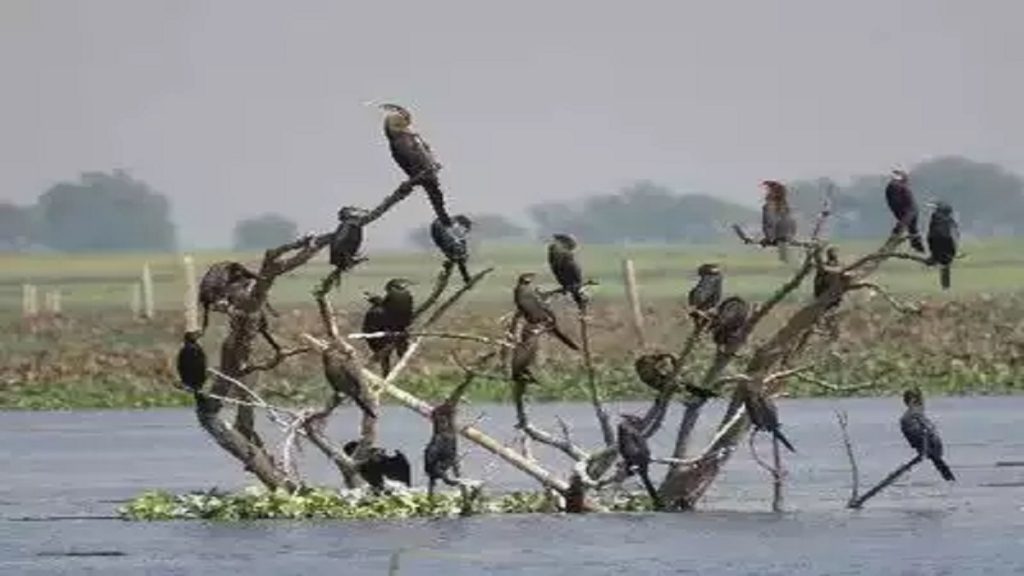Context:
Ahead of World Wetlands Day on 2nd February, four more sites have been designated as Ramsar sites in India.
More on the News
India has added four new Ramsar sites, thus taking the total number of Ramsar Sites in the country to 89.
- These sites are spread in 23 States and 2 UTs of the country.
Now, India stands as the country with the highest number of Ramsar sites in Asia and third highest in the world after the United Kingdom (176), and Mexico (144).
The new sites are – Sakkarakottai Bird Sanctuary and Therthangal Bird Sanctuary in Tamil Nadu, Khecheopalri Wetland in Sikkim, and Udhwa Lake in Jharkhand.
- The Sakkarakottai Bird Sanctuary located in the Ramanathapuram district of Tamil Nadu spans 230.495 hectares along the Central Asian Flyway and are critical breeding and foraging ground for waterbirds.
- Therthangal Bird Sanctuary (TBS) is also located in the Ramanathapuram District of Tamil Nadu.
- Khecheopalri Lake is located at West Sikkim at an altitude of 1700 m.
- Udhuwa or Udhwa Lake is situated in the Sahebganj district of Jharkhand. The Sanctuary has two water bodies i.e. Patauran (155 ha) and Berhale (410 ha), interconnected by a water channel.
The Khecheopalri Lake and Udhwa Lake are the first-ever sites from Sikkim and Jharkhand.
Tamil Nadu now has 20 Ramsar sites and continues to have the highest number of Ramsar sites in India followed by Uttar Pradesh with 10 sites.
About Ramsar Sites and their Conservation
Ramsar sites are wetlands that are designated as being of international importance.
They are listed on the Ramsar List, which is the world’s largest network of protected areas.
The Ramsar Convention, also known as the Convention on Wetlands of International Importance, is an intergovernmental agreement for promoting the conservation and wise use of wetlands.
- It is the only global treaty to focus on a single ecosystem.

The Convention was adopted in the Iranian city of Ramsar on 2nd February, 1971 and came into force in 1975. The Convention came into force in India in 1982.
- 2nd February every year is celebrated as World Wetlands Day.
Its Secretariat is located in Gland, Switzerland.
Ramsar Sites in India
- The first Ramsar Sites designated were Chilika Lake (Orissa) and Keoladeo National Park (Rajasthan) in 1981.
- Largest Ramsar Site: The Sundarbans (West Bengal) hold the distinction of being the largest Ramsar Site, which spreads to an area of 4230 sq. km.
- Smallest Ramsar Site: Renuka Wetland – Himachal Pradesh – (0.2 sq. km.)
- These wetlands are protected under various national laws, including the Indian Forest Act (1927), the Forest (Conservation) Act (1980), Environment (Protection) Act, 1986, and the Indian Wildlife (Protection) Act (1972).
Process for Declaring a Wetland as a Ramsar Site in India
- The Ministry of Environment, Forest, and Climate Change (MoEFCC) serves as the nodal ministry for wetland conservation.
- The concerned state government submits a proposal to the MoEFCC, recommending the wetland for Ramsar designation.
- Upon approval by the MoEFCC, the proposal is submitted to the Ramsar Secretariat for consideration.
- The Ramsar Secretariat reviews the submission and if the site meets the necessary criteria, it is added to the List of Wetlands of International Importance, officially designating it as a Ramsar Site.
Recent Developments in Wetland Conservation in India
- Wetlands (Conservation and Management) Rules, 2017: It has enhanced the focus on the management of wetlands from a central authority to state bodies.
- Wetlands of India Portal: Launched in 2021, by the Ministry of Environment, Forest, and Climate Change (MoEFCC), this portal provides comprehensive information on India’s wetlands.
- Centre for Wetland Conservation and Management (CWCM): Established on World Wetland Day 2021, this centre focuses on addressing research needs and knowledge gaps in wetland conservation.
- Wetlands Rejuvenation Programme: Initiated by MoEFCC in 2020, this program aims to rejuvenate over 500 wetlands across India.
- The National Wildlife Action Plan (2017-2031): It emphasizes the conservation of inland aquatic ecosystems, including wetlands.
- Amrit Dharohar Scheme: Launched in the Union Budget 2023-24, it is aimed at optimizing wetland utilization over the next three years.
- Mission Sahbhagita: Launched on the occasion of Azadi ka Amrit Mahotsav, it is an important step towards participatory conservation and wise use of wetlands to enable a society ownership approach with communities leading at the forefront.

